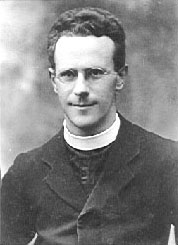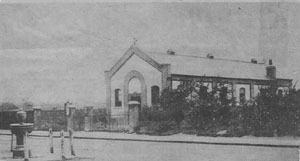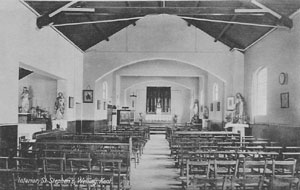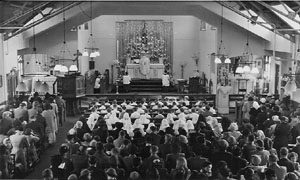A History of the Parish
In the early 1920s Welling was very much a country village. To the north of Bellegrove Road were fields and heathland, and to the south were some orchards.
There were very few Catholics living in Welling, and those who did would walk to St. Benet's Church in Abbey Wood to attend Mass. House-building began in a modest way at this time due an acute shortage of housing following the 1914-18 war. The parish priest of St. Patrick's, Plumstead, Rev. Daniel McCarthy, could foresee the development of house building and brought this fact to the attention of Bishop Amigo. The bishop instructed Fr. McCarthy to negotiate the purchase of a site and build a church. The site chosen was between Welling Corner and where Novo Gym stands today (formerly, for many years, Woolworths). At the time, this area was not built upon, but opposite there was a row of houses and a single building which housed a small library. There was also a drinking fountain and a small hall behind it which was a non-conformist church.
This church was constructed as a "lock-up" Chapel-of-Ease, only open for Sunday Mass and evening service if the numbers warranted it. The church building was started in May 1923 and was blessed on 19th December. Mass was celebrated for the first time on Christmas Day 1923, but the recognised official opening was on St. Stephen's Day. The total cost of the church was £2,688. The chairs and kneelers were obtained from St. Benet's, Abbey Wood.
For the first six years the church remained a Chapel-of Ease and was served by clergy from Plumstead. Fr. Cecil Preedy, curate at St. Patrick's, made a great deal of effort to create some social atmosphere by holding dances and whist drives in a wooden hall on the south side of Welling Approach. The younger element from Plumstead were encouraged to attend these functions, and would walk home across the fields with Fr. Preedy.
Then in 1929 St. Stephen's became an independent parish. In October of that year a young Fr. Clifford Nevatt came to Welling as the first parish priest. There were no funds, but the purchase of an old-type house diagonally opposite the church was negotiated, so this could be used as a presbytery. Fr. Nevatt had quite a struggle and used all manner of means to raise money.
 Fr. Nevatt's first attempts to be a priest had failed as he had been sent
away from the seminary on the grounds that the studies were too difficult
for him. He had tried the contemplative life in a Cistercian monastery
but had left of his own accord, feeling that this was not his vocation.
After a short period of working in an insurance office he reapplied to
the seminary where he was accepted, and was ordained in 1919.
Fr. Nevatt's first attempts to be a priest had failed as he had been sent
away from the seminary on the grounds that the studies were too difficult
for him. He had tried the contemplative life in a Cistercian monastery
but had left of his own accord, feeling that this was not his vocation.
After a short period of working in an insurance office he reapplied to
the seminary where he was accepted, and was ordained in 1919.
He was quite an ordinary man in many respects, who at first sight made no particular impact. One of his great assets was his quiet smile which immediately put one at ease. He was easy to talk to and was a good listener. His replies went straight to the point, even though the truth was sometimes difficult to hear.
Mass continued to be said in the original church on Welling Corner for 6 years after the parish of St. Stephen's became independent. Sunday attendances numbered 220 then and the collection raised £2 a week.
The rapidity with which Fr. Nevatt built up a full-scale parish was quite incredible. His priestly ministry was governed by the basic premise: "School first, church second". He was convinced that given a school, he was given the children; given the children he was given the parents, and given the parents he was given a Parish. With his vision for the future and the help of Mr. Robert Farrell whom he had met when curate at Lewisham, he made immediate purchases of land and at once began negotiating the building of schools and church. First the site at Welling Corner where Poundland now stands for the first Primary school then the site adjacent to the woodyard and alongside the railway as far as the station for a larger Primary school and later a Secondary school.
Fr. Nevatt invited the Daughters of Jesus to his Parish and asked them to take the direction of his school. As with his curates, so with his Sisters, he wanted the very best and expected to receive it from them. The Daughters of Jesus were already conducting flourishing Catholic schools in the neighbouring parish of Bostall Park, and Fr. Nevatt could think of no better teachers for his own school.
In 1933, on January 9th, the small but attractive school at Welling Corner opened its doors to 80 small pupils. All seemed set for a happy start, but sickness beset the staff from the first day. On the opening morning, due to the illness of the headteacher and the absence of the Infants' teacher, help had to be sought from St. Joseph's Convent. Equipment was in short supply, the furniture and stock having arrived only the day before, Sunday. It was discovered that same afternoon - there was so little stock for immediate use that it had been hidden behind a piano! Thanks to St. Joseph's Convent the children had sufficient books and paper to carry them over for the first few days. On that first morning, whilst waiting for heip to arrive, all the children were gathered into the large Infants' room, where there was a piano, for an improvised singing lesson to pass the time.
The difficulties at that time were enormous. The school roll increased so rapidly that it was impossible to forecast with any degree of accuracy the requirements of the following weeks. There was a constant re-organisation of classes, and a steady transfer of pupils from one class to the other. The number of pupils applying for admission far exceeded the numbers expected, so that the classes were large, very large at times, and it was several weeks before the school settled down.
As the new school was becoming established Ft. Nevatt realised that in order for it to play its full part in the life of the parish, some sisters would need to "live on the spot" and be members of the parish community. His plan was realised on 14th September 1933 when the first group of seven sisters took possession of their convent, "Maryville", in Bellegrove Road, where the present Maryville flats stand opposite Blockbusters today.
The community's first Mass together was celebrated on the feast of Our Lady of Seven Sorrows, and that first Mass launched them into many years of happiness. The following Sunday they were introduced to the parish at Sunday Mass. Fr. Nevatt met them at the church door and led them down the church to the front bench, which was from then on always reserved for the sisters.
In 1935 the Parish Hall was erected alongside the railway and some distance from the church and presbytery which were still at Welling Corner. As the school roll increased, the hall subsequently housed two classes of Junior children and later, after the sale of the church, it was also used for Mass on Sundays whilst waiting for the new, larger church to be built. Occasionally a wedding party arrived during school hours and caused an interesting diversion. At Sunday Mass the classroom goldfish were a quiet distraction as they swam with gaping mouths around the bowl on the window-sill. After a few years the original school was sold, and in 1936 the Primary pupils moved into new buildings which had access from Ruskin Avenue.
The present church opened in December 1935 and cost £3,375. Mass attendance then was 870. The district continued to grow with 1,000 worshipping on Sundays in 1936.
The interior appearance of the church was somewhat different from that of today. The ceiling was lower and one visiting priest remarked upon the tunnellike appearance. The pulpit had come from the original church and had steps leading to it from behind the pillar next to Our Lady's altar. The sanctuary was separated from the main body of the church by altar rails.
During the war a church in the London area was bombed and soon after the war Fr. Nevatt purchased the damaged organ and part of the organ loft and stairway. The task of building a loft in the present church was undertaken voluntarily by skilled men of the parish. Due to the low ceiling it became necessary to remove it completely exposing the steel girder work and underside of the roof. An organ fund was started for the purpose or repairing the organ and replacing the organ pipes.
In due course Fr. Nevatt acquired the land at Gravel Hill on which St. Columba's secondary school now stands. Finally he purchased the land at Blackfen on which he later had built the small Church of the Holy Rosary. He was convinced that the future of his parish would depend on the quality of its schools, and he saw the children of today as the families of tomorrow.
Within a few years St. Stephen's parish had mushroomed, but thanks to the foresight of Fr. Nevatt and Mr. Farrell, the ever-growing numbers of parishioners were well provided for. When the schools were built and the larger present church was opened some people complained, and maybe rightly so, that the parish buildings were all of a temporary nature. This was partly because of Fr. Nevatt's determination to get things done quickly, so that all the Catholic children of his Parish would be in Catholic schools. He was particularly concerned that the younger children should begin school in a Catholic atmosphere.
Interestingly enough, when a 1,000 lb bomb fell in the playground during the war all the brick parts of the schools were badly damaged, but the pre-fabricated structures were able to withstand the blast. The wooden panels were dislocated, but did not collapse and in a very short time the school was functioning in a fairly normal way.
Fr. Nevatt's lasting influence on the parish of St. Stephen's stemmed from his life of deep prayer. The attraction to contemplative prayer which had drawn him to a monastery remained with him, and at intervals throughtout the day he could be seen at prayer in the sanctuary of his church. For two weeks each year the parish was handed over to missioners for a Parish Mission. During the war, when there was a prisoner-or-war camp on Shooters Hill, he arranged a Sunday 9am Mass especially for the prisoners. This became known among parishioners as The German Mass where all were united in prayer and hymns were sung in German.
One of the characteristics of the Maryville community was the presence of the sisters at the parish services. The church was a quite a long way from the convent and each day they trudged up and down to Mass. Some walked to school twice a day and not infrequently went back again for a mission service or some other parish event. It was a tough life for those sisters walking up and down Bellegrove Road.
As the numbers attending St. Stephen's increased, the size of the church became inadequate, particularly at the 10.30 am Mass, which was the most popular one. The situation was even worse at a special service or at Christmas Midnight Mass. Fr. Nevatt's answer was to build an annex outwards from the Sacred Heart altar and to fit tip-up seats at the end of each bench in the main church.
In 1961 Fr. Nevatt, who had lived to see the fruits of his work blossom, died after 32 years as parish priest. He was succeeded by Fr. Canon Jeremiah McCarthy, who was parish priest of St. Stephen's for 12 years. During his time in Welling, he made some structural alterations to the sanctuary and filled in the unsightly girders in the ceiling which had been exposed soon after the war. The lighting and heating were also improved. The first phase of St. Columba's school was built in Bexleyheath, which relieved the overcrowding at St. Stephen's Senior School. The girls moved on to St. Catherine's when it opened, whilst the first two years of St. Columba's (as it was now called) remained at Welling until shortly before the new primary school was built. Fr. John Lennon, who also became Canon, succeeded the late Canon McCarthy in November 1973.
This article on the history of St. Stephen's Parish is based partly on an account written for the Golden Jubilee of the school in 1983 by Mother Francis Mary, who taught at St. Stephen's School from April 1937. She was headmistress from September 1946 until 1958. A lot of the historical detail is taken from an account of the early years of the parish written in 1977 by a former parishioner, John McCarthy, for the original parish magazine.
Parish Priests of St Stephen's
Dates |
Parish Priest |
|---|---|
1929 — 1961 |
Fr. Clifford Nevatt |
1961 — 1973 |
Canon Jeremiah McCarthy |
1973 — 1987 |
Canon John Lennon |
1987 — Dec 1995 |
Fr. Patrick Maloney |
Jan 1996 — Dec 2006 |
Fr. Peter Ryman |
Jan 2007 — Aug 2018 |
Fr. James Spencer |
Sep 2018 — Present |
Canon Edward Perera |






